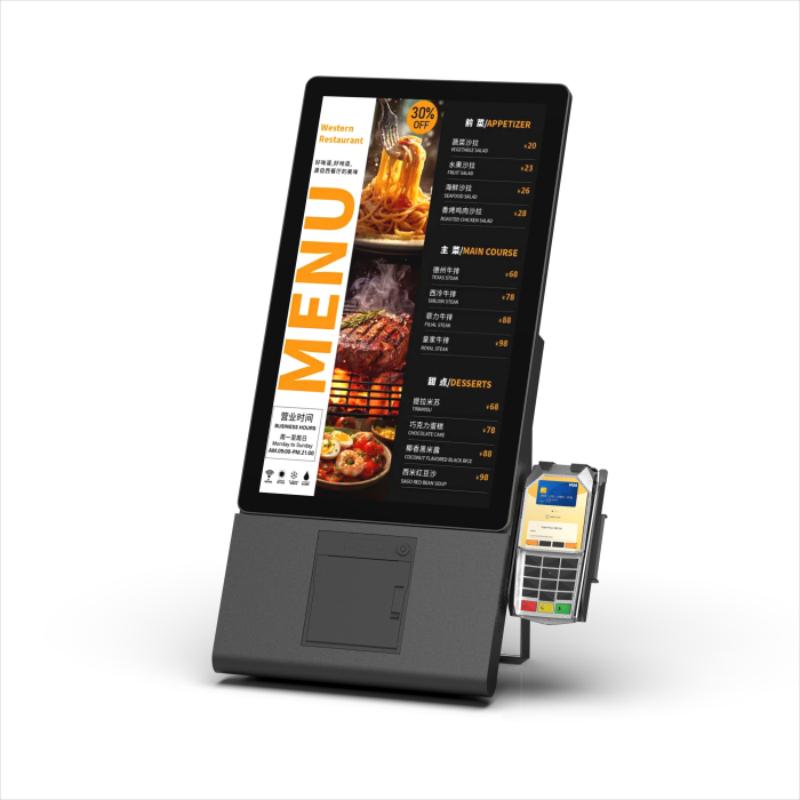A self-ordering kiosk LCD touch screen refers to an interactive terminal equipped with a touch-sensitive LCD screen that allows customers to independently browse menu items, customize their orders, and complete transactions in various retail and hospitality environments.
1. Touch-Sensitive Interface: Features a responsive touch screen that enables users to navigate through menu options, select items, and input preferences directly by touching the screen.
2. LCD Display: Utilizes an LCD (Liquid Crystal Display) screen to present visual menus, item descriptions, pricing, and promotional content in clear, high-resolution graphics.
3. Integrated Computing System: Contains a built-in computer or computing device capable of running specialized software applications for menu display, order management, payment processing, and integration with back-end systems.
4. Menu Navigation and Customization: Provides intuitive menu navigation with options for users to browse categories, view item details, select modifiers (e.g., toppings, sides), and personalize orders based on preferences.
5. Ordering Process: Guides users through the ordering process step-by-step, allowing them to add items to their cart, review selections, modify orders, and confirm transactions directly through the kiosk interface.
6. Payment Options: Supports various payment methods including credit/debit cards, mobile payments (e.g., NFC), cash handling (if applicable), and gift cards, ensuring flexibility and convenience for customers.
7. Multilingual Support: Offers language options and user interface settings to accommodate diverse customer demographics, enhancing accessibility and user experience for non-native speakers.
8. Accessibility Features: Incorporates features such as adjustable font sizes, audio outputs for instructions or alerts, and tactile feedback options to support users with disabilities and ensure inclusivity.
9. Security Measures: Implements robust security protocols to protect customer data and payment information, including encrypted transactions, secure PIN entry, and physical security enhancements.
Self-ordering kiosk LD touch screens are designed to streamline the ordering process, reduce wait times, and enhance customer satisfaction by providing a self-service solution that is user-friendly, efficient, and capable of handling high volumes of transactions in various retail and hospitality settings.

- Improved Customer Experience : Provides an engaging and efficient way for users to access information or complete transactions.
- Cost Savings : Reduces labor costs and can lead to increased sales through targeted promotions and easy access to product information.
1. User Interface (UI) and User Experience (UX):
- Customizable Menus: Design intuitive menu layouts with customizable categories, item placements, and pricing structures that reflect the business's offerings.
- Personalization Options: Allow customers to customize orders by selecting modifiers and specifying preferences directly through the interface.
2. Branding and Visual Design:
- Branded Interface: Integrate company logos, color schemes, and graphical elements into the kiosk's user interface to align with brand identity and enhance brand visibility.
- Customizable Themes: Offer themed templates or seasonal designs that can be easily updated to reflect holidays, events, or marketing campaigns.
4. Language and Accessibility Features:
- Multilingual Support: Provide language selection options to accommodate diverse customer demographics and enhance accessibility for non-native speakers.
- Accessibility Enhancements: Include features like adjustable font sizes, audio prompts, and tactile feedback for users with disabilities to ensure inclusivity and compliance with accessibility standards.
5. Integration with Back-end Systems:
- POS Integration: Integrate with point-of-sale (POS) systems and kitchen management systems to synchronize orders, update inventory in real-time, and streamline order fulfillment processes.
- CRM Integration: Capture customer data and preferences through loyalty programs or customer accounts, enabling personalized recommendations and targeted marketing strategies.
6. Hardware Customization:
- Display Options: Choose LCD or LED displays with varying sizes and resolutions to optimize visibility and fit within the kiosk's physical space and viewing distances.
- Peripheral Integration: Include additional hardware components such as bar-code scanners, receipt printers, card readers, and cameras based on specific operational requirements.
7. Security and Compliance:
- Data Security: Implement stringent security measures such as encryption protocols, secure payment processing, and physical security features (e.g., locking mechanisms) to protect customer data and transactions.
- Regulatory Compliance: Ensure compliance with industry regulations and standards related to data protection, payment security (PCI-DSS), and accessibility (ADA compliance).
Customizing self-ordering kiosk LCD touch screens empowers businesses to create personalized, efficient, and engaging customer experiences while optimizing operational efficiency and driving revenue growth in retail, hospitality, and other service-oriented industries.